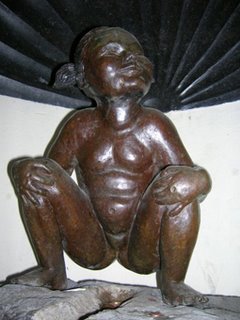
Strofilia is more a spacious wine bar than a restaurant, since the menu only features meze. There are no main courses, no desserts, and the wine list is almost longer than the food menu. This is a pity, as a vast space like this in such a prime location could be put to a more profitable use. They have a thriving outside catering business, and I suspect the restaurant is for the moment simply a flagship for more profitable activities. There has obviously been serious investment in the decor, in an effort to avoid the kitschy image of cheaper Greek tavernas. Discreet Hellenic music plinks in the background, but nobody is going to drag you up to do the sirtaki. However, just to be on the safe side I avoided the ouzo.
The menu at first appears vast, until you realize that it is in four languages – Dutch, French, English and Greek, and in fact the choice is not that great. There are cold and warm meze, a few salads and the usual tzatziki, tarama, etc. (which I would classify as 'dips' rather than starters, but what do I know). No dolmades, sadly. I'm very partial to a dolma. They recomment 4 to 5 dishes for two people, so we chose to share a Brochette Asie Mineure (minced lamb with pine nuts and oriental spices) and an aubergine roulade stuffed with minced meat and tomato sauce, accompanied by roast baby potatoes with rosemary, and roasted Mediterranean vegetables with garlic and saffron sauce.
The prices at Strofilia are quite steep, ranging from 7,50 euros to 13 euros for dishes which were little bigger than appetizers. The food was well presented and tasty, although Tara searched in vain for any sign of the precious saffron in the vegetables. We accompanied our food with a bottle of Megapanos Nemea, a full-bodied red from the Peloponnese, which was perfectly drinkable in a southern Mediterranean sort of way, but at 28 euros was a tad overpriced. Some of the wines on the wine list were not far short of 50 euros a bottle, which, unless your name is Niarchos, is fairly outrageous. To finish off the wine we had a selection of Greek cheeses. The salty manouri and smoky kapnisto were offset nicely by the bland creamy kefalograviera, but our hunger was only just sated.
Strofilia is a pleasant place to spend a quiet evening with friends, but they could do with expanding their menu and reducing their prices. 72 euros for four starters, a bottle of wine and some cheese, is no gift from the Gods. I was tempted to smash a few plates on the way out to justify the bill. Still, they say less is more. In the case of Strofilia this is certainly true.
STROFILIA
13 rue du Marché aux Porcs
1000 Brussels
Metro: Sainte Catherine







